Tuesday, 2 September 2014
Monday, 1 September 2014
Edit and Evaluation
Edit Evaluation:
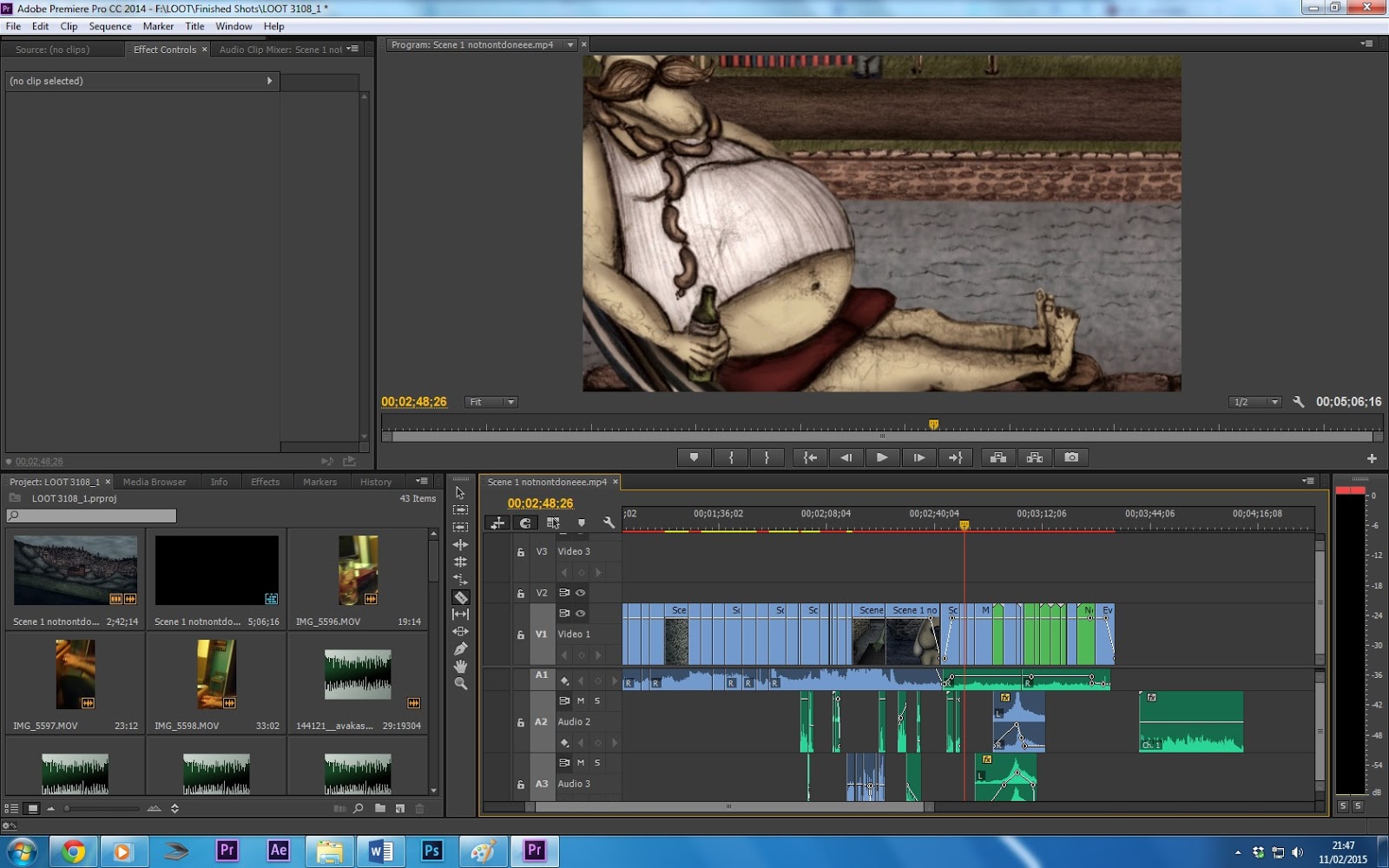 Unlike live motion film, editing the picture of the film was very straight forward, as there wasn't any of shots to pick between. This is because I only animated one take per shot, as animation is so time consuming (and I knew what I was animating and how it would all piece together before hand). Also unlike live motion film, I edited the film as I went along, so when each shot was finished I added it to the timeline.
Unlike live motion film, editing the picture of the film was very straight forward, as there wasn't any of shots to pick between. This is because I only animated one take per shot, as animation is so time consuming (and I knew what I was animating and how it would all piece together before hand). Also unlike live motion film, I edited the film as I went along, so when each shot was finished I added it to the timeline.
Once the shots were all in the correct order, I cropped them down to increase the pace of the film. I added a few fade transitions at the beginning and end of the film, as well as using them to separate each scene. I also added in pans, and zooms via fiddling with the motion key frames, and added a split screen into one of the shots.
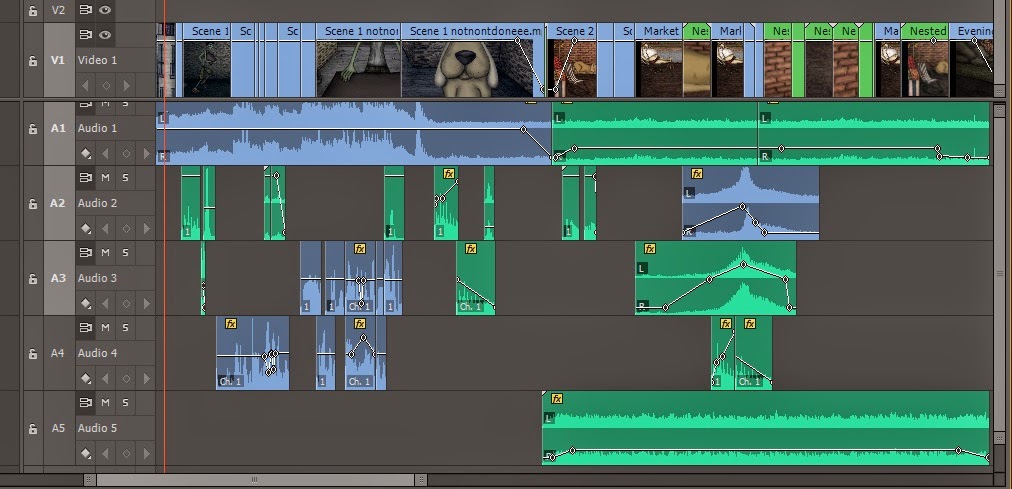 Audio Evaluation:
Audio Evaluation:
I found audio a lot more complex when it came to editing the film together, as there was a lot more layering and blending to deal with.
I firstly added the diegetic (atmospheric) sound to the film for each scene. Then starting from the beginning of the film I went through and added the sound effects (the foley sound and voice acting I recorded, as well as the royalty free sound I downloaded from the internet). Lastly, I added the non-diegetic sound (the score/soundtrack) to the film.
When applying each sound file to the timeline, I had to fade in and fade out each sound, so that they would blend in to one another.
 Unlike live motion film, editing the picture of the film was very straight forward, as there wasn't any of shots to pick between. This is because I only animated one take per shot, as animation is so time consuming (and I knew what I was animating and how it would all piece together before hand). Also unlike live motion film, I edited the film as I went along, so when each shot was finished I added it to the timeline.
Unlike live motion film, editing the picture of the film was very straight forward, as there wasn't any of shots to pick between. This is because I only animated one take per shot, as animation is so time consuming (and I knew what I was animating and how it would all piece together before hand). Also unlike live motion film, I edited the film as I went along, so when each shot was finished I added it to the timeline.Once the shots were all in the correct order, I cropped them down to increase the pace of the film. I added a few fade transitions at the beginning and end of the film, as well as using them to separate each scene. I also added in pans, and zooms via fiddling with the motion key frames, and added a split screen into one of the shots.
 Audio Evaluation:
Audio Evaluation:I found audio a lot more complex when it came to editing the film together, as there was a lot more layering and blending to deal with.
I firstly added the diegetic (atmospheric) sound to the film for each scene. Then starting from the beginning of the film I went through and added the sound effects (the foley sound and voice acting I recorded, as well as the royalty free sound I downloaded from the internet). Lastly, I added the non-diegetic sound (the score/soundtrack) to the film.
When applying each sound file to the timeline, I had to fade in and fade out each sound, so that they would blend in to one another.
Sunday, 31 August 2014
Wednesday, 23 July 2014
Rough Cut
Rough Cut:
Review:
This is the rough cut which includes all of the finished shots edited together, although I plan to cut some of the shots tighter in the tugging sequence, and add all of the sound to the film.
The score and some sound effects will be downloaded from royalty free sights and credited, although the majority of the sound effects will be foley sound or voice acting I will record at home or in college.
Review:
This is the rough cut which includes all of the finished shots edited together, although I plan to cut some of the shots tighter in the tugging sequence, and add all of the sound to the film.
The score and some sound effects will be downloaded from royalty free sights and credited, although the majority of the sound effects will be foley sound or voice acting I will record at home or in college.
Tuesday, 22 July 2014
Process and Equipment Set Up
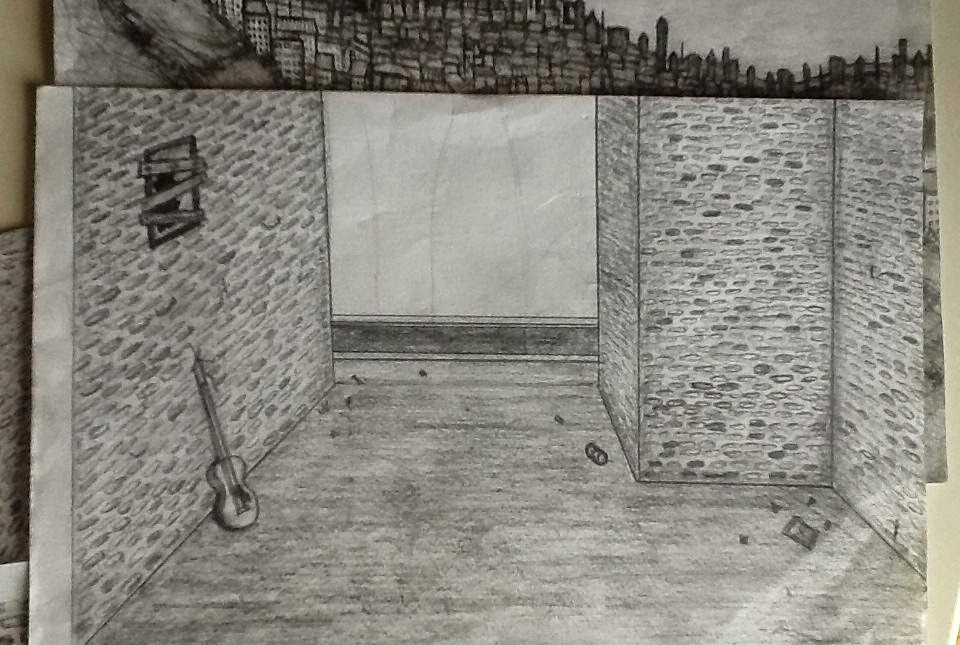 Process: Background
Process: BackgroundFirstly for each shot, I started with the background. I sketched on A4 paper the background and any objects that didn't need to move. (In this case the guitar and rubbish).
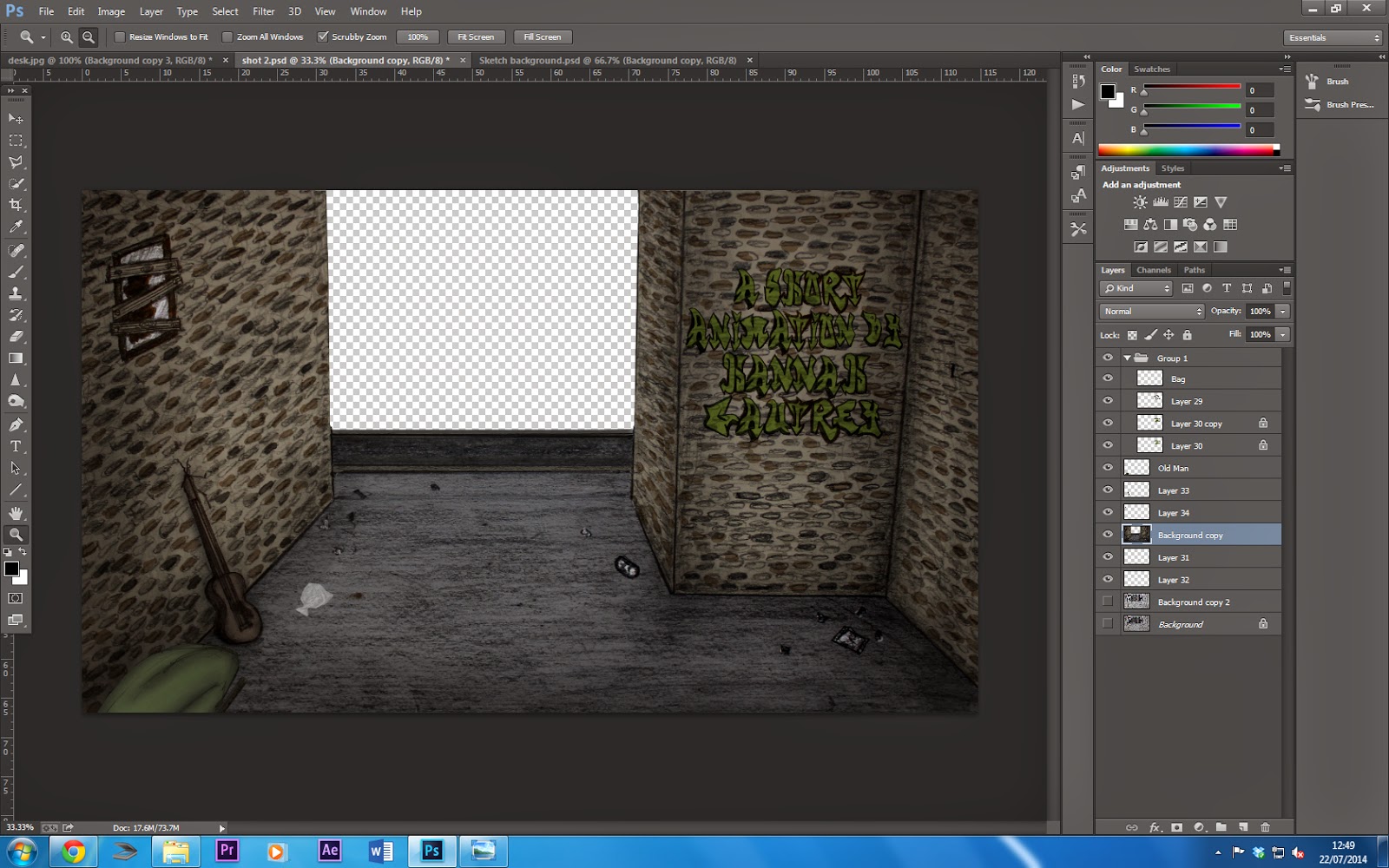 -The reason I have left the background blank, is because I've drawn the town separately, that way I only need to draw it once and can use it in other shots.
-The reason I have left the background blank, is because I've drawn the town separately, that way I only need to draw it once and can use it in other shots.Then, I scanned the sketch in, and coloured it on Adobe Photoshop. Once this was done, I went round the objects shading them to add more depth, and did the same with the background, to add shadow.
Once I'd finished the background, I saved it as a PDF, as if it's saved as a JPG for example, I will be able to bring it into After Effects, but won't be able to move or adjust the layers.
Then, I sketched the characters or objects that I wanted to move.
When making the characters or objects move, I experimented a little, and used a variety of techniques and processes for each shot.
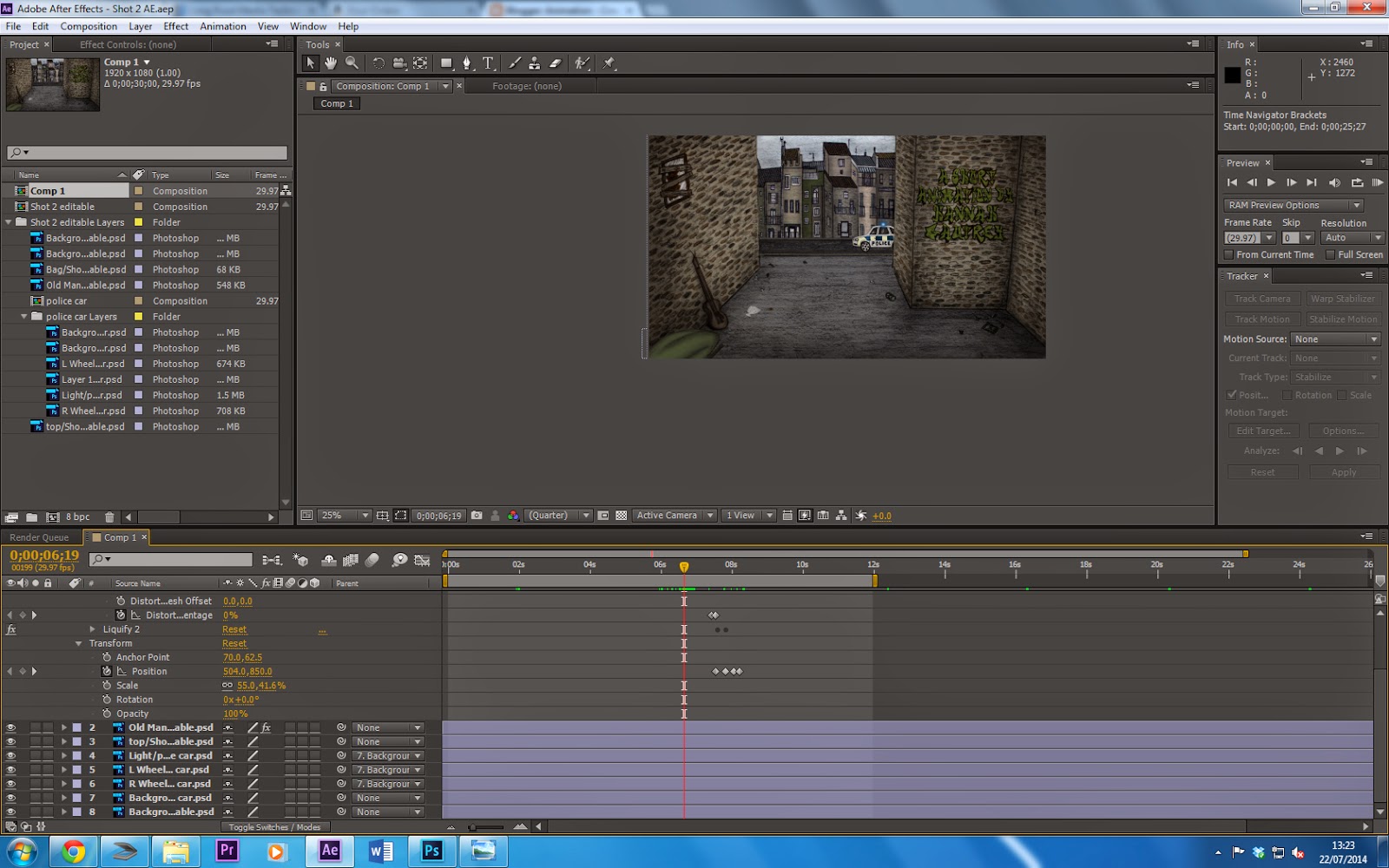 In this particular shot, the only things I wanted moving were the plastic bag, and the police car.
In this particular shot, the only things I wanted moving were the plastic bag, and the police car.This consisted of rotating, re-positioning, and warping the plastic bag, and for the police car, repositioning the car, making the wheels rotate and making the light flash on and off. All of these things could be easily done on Adobe After Effects, so for this shot, I took that route.
I drew the objects in a separate Photoshop document, and then brought them into the background document once they were complete, keeping them on a separate layer, so they can be adjusted in After Effects.
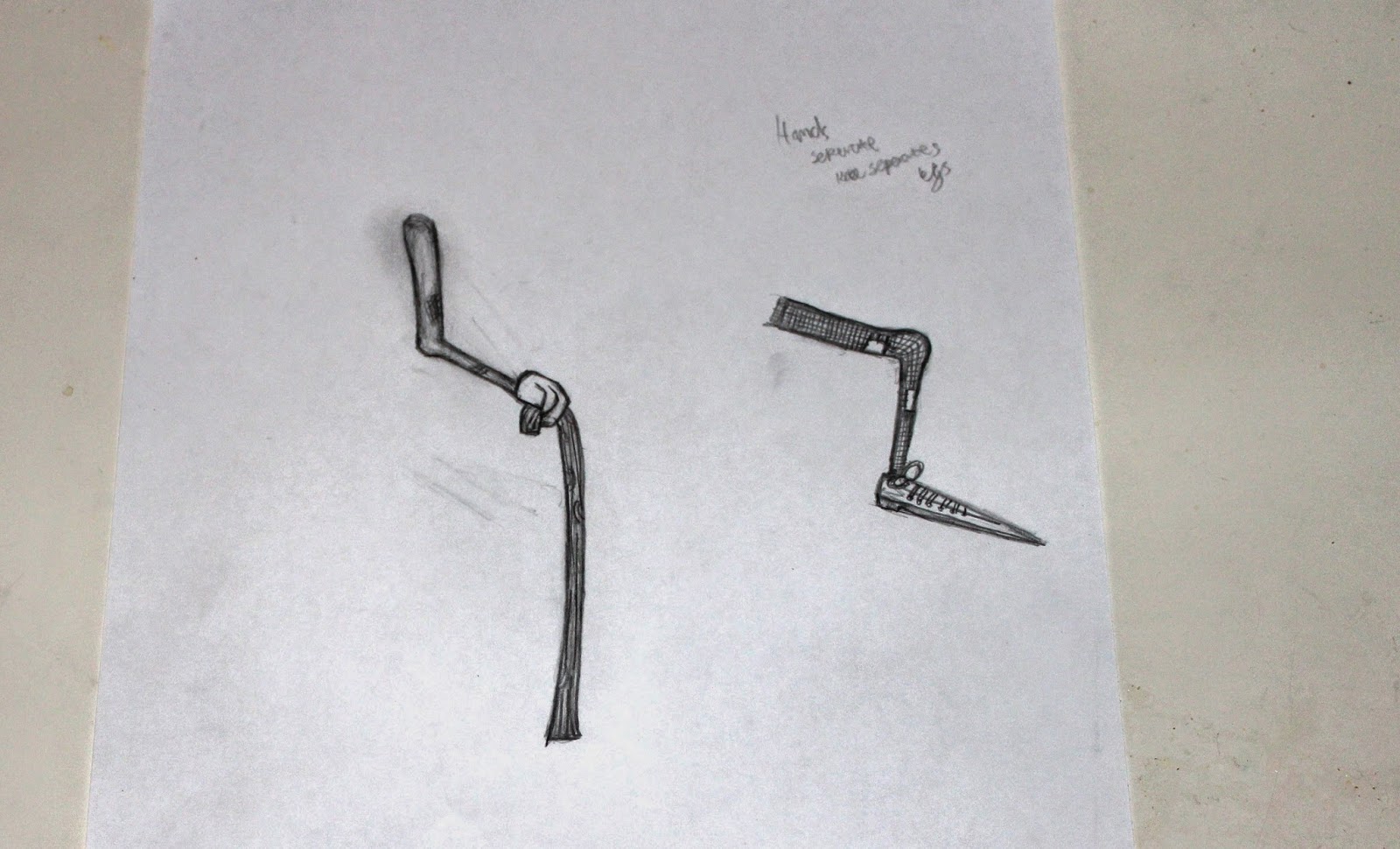 Another way I made the characters move, was via Photoshop. For this shot, I wanted the character Owen, to walk towards the brief case with his walking stick. This meant I couldn't just draw the character as a whole, but needed to draw some body parts separately. Once I had coloured Owen on Photoshop, I had two options, move him into After Effects, or take the longer route of Photoshop. I attempted After Effects to save time, but found that I couldn't move his legs, (as although they were detached from one another, one of the legs was connected to his stomach, which would have been extremely tricky to get round on AE.)
Another way I made the characters move, was via Photoshop. For this shot, I wanted the character Owen, to walk towards the brief case with his walking stick. This meant I couldn't just draw the character as a whole, but needed to draw some body parts separately. Once I had coloured Owen on Photoshop, I had two options, move him into After Effects, or take the longer route of Photoshop. I attempted After Effects to save time, but found that I couldn't move his legs, (as although they were detached from one another, one of the legs was connected to his stomach, which would have been extremely tricky to get round on AE.)So what I did on Photoshop, was rotate the legs and arms ever so slightly in each frame (and for the leg attached to his stomach, used liquify), and saved each movement as a JPEG frame, piecing the frames together on Premiere Pro.
After making Owen move on Photoshop, I decided not to use that process again, and made Ratty's run cycle partly frame by frame. What I did, was draw his head and body once, as they only required a little bit of movement. I then drew his arms once, as all they needed to do was rotate, (but these were drawn separately). Lastly it was the legs that I made via hand-drawn cell animation, as each position was different.
(This was done on Photoshop)
The reason this process was my favourite, is because it was the most challenging, and looks the nicest. By doing hand-drawn cell animation, you can add more movement and exaggeration to the shot - although its not as smooth as CG.
Equipment set up
The software I use, is Adobe Photoshop, Adobe After Effects, and Adobe Premiere Pro. Although I do the animation on Photoshop and After Effects, I bring each finished shot into Premiere Pro, and edit the shots into a film.
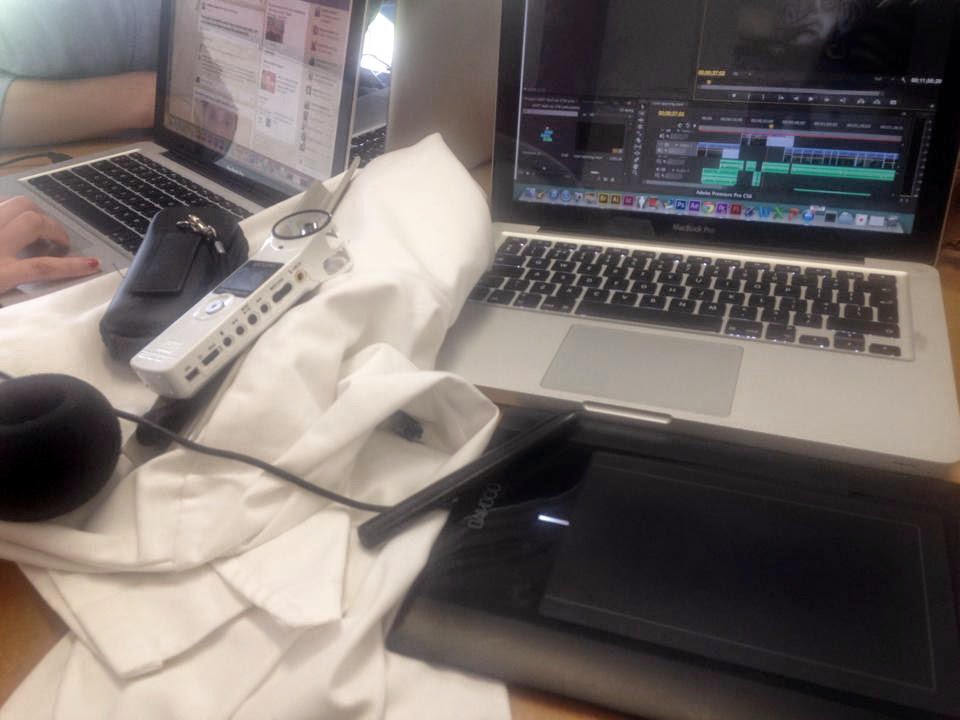 My desk usually consists of an Apple laptop, a Wacom graphics tablet, and my Red progress book. On some occasions, it will also consist of a recording microphone, wind protector, equipment for foley sound, and paper and penicls for drawing.
My desk usually consists of an Apple laptop, a Wacom graphics tablet, and my Red progress book. On some occasions, it will also consist of a recording microphone, wind protector, equipment for foley sound, and paper and penicls for drawing.Saturday, 12 July 2014
Current Status
Animation Status:
I am currently 2.02 minutes into my
animation, and I intend to finish the first scene over the summer holidays. I
also need to improve and add sound to the film, and choose an appropriate
score.
Check List Status:
I have five more blog posts to catch up
on, four of which I can do in a day, and the other being the finished animation
- which I will work on throughout the holidays.
Problems
I won’t finish all three scenes, (as I
haven't even completed the first yet) therefore the film's narrative wont go anywhere.
Wednesday, 28 May 2014
Ratty's Running Cycle
 By referencing from various run cycles on Google, I took my character Ratty and drew him into each of these positions. I ended up drawing his legs 12 times, although drew the body, head and arms once, and adjusted them via Photoshop.
By referencing from various run cycles on Google, I took my character Ratty and drew him into each of these positions. I ended up drawing his legs 12 times, although drew the body, head and arms once, and adjusted them via Photoshop.
I firstly sketched out the position of the legs and then scanned them into Photoshop, then I added the body, making it move ever so slightly each time the leg position changed. Once this was done, I drew the arms, and rotated them depending on what position they needed to be in, added the head, and lastly coloured each frame.
Here is the sketched version:
Here is the cycle:
Friday, 16 May 2014
Oscars Walk Cycle
Here is the walk cycle I produced today for Oscar the dog. I First sketched the dog out, then traced over the legs moving them ever so slightly each time (referencing from other walk cycles on the internet). I only drew the head once, but drew the legs 11 times in different positions and Photoshoped the same head on later. I then coloured each of the frames, and shaded them. Once I was done, I brought the 11 frames into After Effects, created the moving walk cycle, and then took the composition into another project, adding the background.
Walk Cycles:
Finished Shot
Thursday, 8 May 2014
Wednesday, 7 May 2014
Initial Planning
1) Form - I am planning on making a short film with a duration of 3 minutes aimed at all ages, preferably families. It has a simplistic, -easy to follow- plot, so young audiences will be able to understand it, and the colours and topics it's based around can also relate to an older audience.
2) Animation type - It will be a 2D hand-drawn cell animation, but there will also be shots which require less movement, which will be computer generated on Adobe After Effects. The reason for my choice is because I have experimented with other animation types, and have found they were not for me. Rotoscoping was not the style I intended for, as I wanted to design and exaggerate my characters, and wanted the animation to look smooth. I didn't want to use Flash, as I preferred and am more familiar with the work space in After Effects for computer generated animation.
The reason I am doing hand drawn cell animation, is because it gives me more freedom with the movement of my animation, as not all shots can be done computer generated (proportions changing drasticly, and objects completely changing shape and form etc..)
The reason I am also doing computer generated on After Effects, is because with the time I have to create my animation, I wont get it finished, so to save time, will do the more simplistic and shots with less movement on After Effects.
- It shouldn't be too noticeable flicking between the two different animation styles, as the background for the cell animation will remain the same (not changing each frame) so the shots have the smoothness a computer generated shot would have.
3) Selection of genre or style - The short film fits into the categories Drama, and Crime most, and has a few comedic elements, although not enough to be placed into that genre.
The Crime is due to the subtle use of drugs the character Ratty is on, the theft (Ratty steals the mysterious briefcase - arguably off Owen or the unknown owner), and the involvement of the police when they catch Ratty, and accuse him of stealing the money.
It also involves a bit of Drama between the two characters Owen and Ratty. Although they do not speak, they don't get along, and fight over the briefcase, and Owen and Oscar aren't so sorry for Ratty when he gets captured.
4) Narrative and Character Development
Plot Summary/Treatment
The short film is centred on a old homeless man, his dog and
their neighbour. The film begins when the old man wakes up to find a mysterious
brief case nearby. He checks it out of curiosity, and finds it is full with an
extremely large amount of cash. Exited as the old man is, he goes round the
corner (leaving the dog with the money) to check if anyone is looking for it.
When he returns, he bumps into his neighbour, who is holding the briefcase.
They both freeze, and then the neighbour makes a run for it, but the old man
trips him up, and they begin fighting over the case. Eventually the neighbour
gets away with the case, and the old man ends up shoved in a bin.
Later on, when the old man and the dog are looking for a
busking spot, they see two police men and a police car. One of the police is
holding the brief case, and the other is pushing the neighbour into the car.
The old man and the dog look at each other, and take a smile of relief/smirk.
They eventually find the perfect busking location in the busy town centre, and the old man starts to play his guitar, although they are receiving no luck with money. The dog then takes out a wad of
money (which he had previously taken from the case) and places it into the old
man’s busking tray. The old man smiles, and pats the dog on the head.
Character Development
The protagonist Owen, and his dog Oscar are the only characters who develop throughout the narrative. Ratty, the selfish, rude and aggressive neighbour, stays exactly the same through out the film. Even when Ratty is being shoved into the police car, he shows no remorse or regret for the situation, drug use or crimes he has done. Bill and Clive also have no character development, as they are only show for a brief moment in a scene, and catching a criminal is just their daily job.
Owen and Oscar, on the other had, do develop their characters. We see Owen begin as a hopeless man, with barely any expression on his face, but his eyes and longing glare show us he's disappointment with life. When Owen first sees the briefcase, no hope or excitement comes to him, just curiosity, as in all the years he has been homeless on the streets, the least thing he expects is to see a case full of thousands of pounds.
The first development in character we see, is in Owen when he opens up the case too find the money. He has hope for the first time in many years, and feels special and overjoyed. This hope gives him motivation to later, try and defend the case he has found, although, at the end of the fight with Ratty, the old man looses all hope again, and returns back to his original stage.
When Owen passes Ratty being pushed into the car, his hope inst returned, but he feels lucky it wasn't him, and quite relieved Ratty has seen justice. This places him in a slightly better mood.
The film then ends with Ratty gaining some of that hope back, but not all of it. At the end when Oscar takes out a wad of money to give to him, he is happy to receive this, (as it's better then nothing) and is more pleased with the loyalty and love received from his dog Owen, then his money. When Owen pats Oscar on the back, we see a hint of that hope returning.
Tuesday, 6 May 2014
Monday, 5 May 2014
Sunday, 4 May 2014
Practise Shot
I chose to animate this shot first as it is a key shot in the short film. It also looked like a challenge, as it was difficult getting the proportions right for the upper lid of the case. I did it by using a pencil, paper, Photoshop and Premiere Pro.
Here is the sketched shot (not done):
Lastly, when everything looked okay, I coloured each frame exactly the same, and brought it into Premiere Pro, as I found tweaking the duration of each frame was easier on this software. (I could also colour correct it on here, but decided not too).
As there are certain things that are difficult/you can't do digitally on After Effects, (such as this shot, as each frame changes quite evidently) it works out best to stick to drawing each frame, as manipulating shots like this on After Effects would be quite complicated with only one drawing of the full brief case.
I firstly drew out the background onto paper, (the wall, ground, and bottom half of the brief case with the money. Then, on 14 separate pieces of paper, drew the top lid and hands in different positions, so that when it is put together, it gives the illusion it is opening up.
I then scanned each image into the computer, and on Photoshop, took the 14 different sketches of the lid, and added the background to them. Before colouring it, I tested the animation on Photoshop, to see if it looked convincing before I coloured each frame. From that I realized I needed to neaten up some lines, and re-adjust the proportions, and also smoothed it up, as it had a very sketchy effect on the top lid, and I didn't want this.
Here is the sketched shot (not done):
Here is the finished shot:
I plan to draw each shot out frame by frame, although for certain simplistic shots with not much movement, use After Effects to save time.
Friday, 2 May 2014
Animation Planning Notes
1) Inspiration - Existing media it shares similarities with?
The short film is based on two characters who have a close relationship similar to Wallace and Gromit, it is about an Old man and his dog, and the dog has the same, if not more intelligence as the man.
2) How are you going to do this?
I plan to do it traditionally, so 2D, hand drawn and frame by frame, although once I have drawn each frame on paper, I will scan each frame into the computer and colour them on Photoshop.
What I need to make this, is a lot of A4 paper, pencils, a rubber, sharpener, Photoshop, After Effects, and Premiere Pro. This is all equipment I can acquire at home or college.
3) Who with?
I plan to work on my own, as it will be practically easier, as I can stick to my own style (it would look odd if the animation changed style every other frame) And I feel with the time we have to great the animation I should be able to get it done in time, on my own.
4) What is it going to look like?
The style is going to be quite sketchy, and very textured. The backgrounds will have quite a bit of detail, and the characters less detailed. The colours are going to be neutral and very earthy, (greens, browns, blues). I plan to make the characters extremely exaggerated.
5) Whats the structure?
Scene 1
- It will begin by introducing the three characters (the old man, Ratty, and the dog) on the streets
- The old man wakes up from a police car going by
- He sees a brief case, and is confused as to why its there
- He walks up to the case, examines it, and opens it, inside is lots money
- He walks round the corner, to check if anyone is around and if they're looking for the money
- Ratty wakes up and sees the money
-The old man turns around to see Ratty with the money, they stand still in shock and stair at each other
-Ratty makes a run for it, but the old man trips him up with his walking stick
- They fight over the brief case
- Ratty gets away with it, and the old man is pushed into a bin
Scene 2
- The old man and the dog are walking in town to find a good busking spot, and see a police car and two police men
- One police man is pushing Ratty into a police car, and the other is holding the brief case
- The old man looks at the dog, and they both smile to each other
Scene 3
- The old man and the dog find a busking spot, and the old man starts playing his guitar
- The dog then leans forward, and places one wad of the money into the old mans busking box
- The old man smiles, and pats the dog on the head
Tuesday, 29 April 2014
How my animation fits into current trends
 I feel my animation will fit into the current marketplace, as the style is different, and original, and recently different styles are becoming popular, such as the French style of animation, examples being The Illusionist and Belleville Rendez-Vous, where the style is a lot more textured, and uses darker and neutral colours. The main character will be likeable, and cute, and the relationship between the man and the dog has been successful before in Wallace and Gromit. The narrative is simple and easy to follow for young audience, yet can still be enjoyable for adults, and teaches a lesson on greed. The storyline is also satisfying, as it ends on a happy note and the protagonist develops hope.
I feel my animation will fit into the current marketplace, as the style is different, and original, and recently different styles are becoming popular, such as the French style of animation, examples being The Illusionist and Belleville Rendez-Vous, where the style is a lot more textured, and uses darker and neutral colours. The main character will be likeable, and cute, and the relationship between the man and the dog has been successful before in Wallace and Gromit. The narrative is simple and easy to follow for young audience, yet can still be enjoyable for adults, and teaches a lesson on greed. The storyline is also satisfying, as it ends on a happy note and the protagonist develops hope.
The animation doesn't fit in with many current trends, as usually animations aimed at families are colourful and attractive for kids, but the colours in this are a lot darker, as it is showing the harsh reality of the characters and the cold streets they are living on. This reminds young audiences of what is around them, and how lucky they are to have a home. It is also 2D, and a lot of recent animated films are 3D, although this might be a positive aspect, as it will stand out.
For promotion, as it is not a TV series, the short film would be entered into film festivals, and screened before features in the cinema, and online, and any publicity it can get.
Target Audience
Name: James Carter
Age: 14
Average day: Goes to secondary school and is currently in year 10, studying all of the required subjects, but his favourite is Art, French and English. After college he plays tennis every Wednesday, and then goes home to watch his favourite animated shows, practises his French, and reads a book before bed.
Hobbies and interests: He loves playing Tennis after school, and rounders in P.E, and loves to read and watch animations, he also loves attending the cinema, and meeting with his friends at the park.
Spending power: James gets most of his money as his birthday and Christmas present, as he isn't old enough to work, although he occasionally does chores around the house for his parents for pocket money, and babysits.
Typical media consumption per day: He watches around 2 episodes or 1 film a day, goes on his Nintendo Wii every other day, and reads every night.
Why the animation will appeal to them (look, style of animation, themes, main character, humour): He loves animation, and also art, so enjoys and has grown up watching 2D animations. As he loves art, he can appreciate the different style of animation, and especially loves the French style. He loves drama and crime based films and TV, and loves watching things set in a different environment to where he lives.
Age: 14
Average day: Goes to secondary school and is currently in year 10, studying all of the required subjects, but his favourite is Art, French and English. After college he plays tennis every Wednesday, and then goes home to watch his favourite animated shows, practises his French, and reads a book before bed.
Hobbies and interests: He loves playing Tennis after school, and rounders in P.E, and loves to read and watch animations, he also loves attending the cinema, and meeting with his friends at the park.
Spending power: James gets most of his money as his birthday and Christmas present, as he isn't old enough to work, although he occasionally does chores around the house for his parents for pocket money, and babysits.
Typical media consumption per day: He watches around 2 episodes or 1 film a day, goes on his Nintendo Wii every other day, and reads every night.
Why the animation will appeal to them (look, style of animation, themes, main character, humour): He loves animation, and also art, so enjoys and has grown up watching 2D animations. As he loves art, he can appreciate the different style of animation, and especially loves the French style. He loves drama and crime based films and TV, and loves watching things set in a different environment to where he lives.
Representation and Ethics in Cartoons
Why does the writer of the article believe Rio 2 is problematic in terms of its representations?
 Rio 2 can be seen as prejudice in areas, due to the lead characters being voiced by white Americans, when they are born and raised in Rio (excluding Blu). The point Steve Rose is trying to make, is that the animation industry is made up of mainly American voice actors, and there are little roles for other ethnicity's' and when other ethnicities are used to voice characters, it is often for a stereotypical reason. He states an example of this, saying most African-American voice actors play the stereotypical part of the comedic sidekicks.
Rio 2 can be seen as prejudice in areas, due to the lead characters being voiced by white Americans, when they are born and raised in Rio (excluding Blu). The point Steve Rose is trying to make, is that the animation industry is made up of mainly American voice actors, and there are little roles for other ethnicity's' and when other ethnicities are used to voice characters, it is often for a stereotypical reason. He states an example of this, saying most African-American voice actors play the stereotypical part of the comedic sidekicks. He also mentions that skin colour is a problem in the film, as the humans shown in Rio 2, are supposed to be Brazilian, but have distinctly lighter skin then most people you would find in Brazil.
What are PEPs and why are they an issue for racial representation?
PEP stands for Problem Context, Entertainment Context, and Performance Context. This is something a man named Dr Charles Da Costa has come up with. Dr Charles Da Costa is an English lecturer who studies and writes about racial stereotyping in animation and believes that genotypes such as black ethnicities, need to be associated with troubling circumstances, which is a racist stereotype.
Why does Da Costa believe we end up with stereotypes in animation?
Da Costa believes we end up with stereotypes because the film industry needs to think more about money and buisness, then moral obligations, and they think about what will make more money instead of what is right.
What does Turbo say about social mobility?
Steve Rose states that social mobility is only available to white characters in animations, as many animations for example Turbo, are based around a white voiced character, being helped,supported and re-enforced by many other ethnicities, such as the comedic side kick voiced by Samuel L Jackson, Snoop Dogg, and Michelle Rodriguez. Friday, 25 April 2014
Budget and Post on Schedule
Information on Scheduling (Research)

Adventure Time Story Process:
Peppa Pig
The Simpsons
Frozen

My Budget:
The animation will take 18 weeks (4.5 months) to produce, and for the crew and cast will be a total budget of £52,325.

Adventure Time Story Process:
South Park
Peppa Pig
Frozen

My Budget:
The animation will take 18 weeks (4.5 months) to produce, and for the crew and cast will be a total budget of £52,325.
Voice Acting

Name of Character: Ratty
Personality of Character: Unapproachable, un-tasteful, rude, rough, heartless, slimy, selfish
Type of Vocal Performance Required: Deep tone of voice as well has high pitch (varied pitch), croaky, grotty

Dream Casting: Andy Circus, as he is brilliant at voicing evil, bad natured characters, such as Golem & Smeagol from the Lord of the Rings, and Golem has similar traits, and vocal performance as Ratty.
Cheaper Alternative: Michael Wincott, who voices characters such as Scroop in Treasure Planet, as this character has a deep, grotty and creepy voice, which would suite the role of Ratty well.
Tuesday, 22 April 2014
Story & Storyboard
Name: Loot
Product Type: Short Film
Running Time: 3 minutes
About: The Short film is about two homeless men, one being Ratty (the foe), and the other being an old man (the protagonist). The old man comes across a brief case one day, and finds a large sum of money in it. Ratty then wakes up, and sees the money, and tries to steal it. The old man attempts to defend the case, and this results in a fight (tugging the case), but Ratty gets away with the case, shoving the old man to the floor. The film then fades into another scene of the old man and his dog walking in town, and they then pass Ratty being pushed into a police car for having the (stolen) money. The old man smiles, please that it wasn't him, and they walk of, and later sit down to busk. The dog then takes out some money from its mouth, and places it into the old man's busking hat (which it had previously taken from the case). The old man smiles and pats the dog.
Character and Story Development: The short film begins on a negative note, as we see that the poor protagonist is on the streets. It then becomes more positive when the old man finds the case full of money, but then an obstacle gets in the way (Ratty) who steals the money. This obstacle is slightly overcome when we see Ratty being pushed into the police car, as he is being punished for his greed, but then is even more overcome when the protagonist (the old man) gets some of the money from the case.
The old man has lost all hope of getting of the streets, but when he finds the case full of money, he begins to think of all the possibilities. The old man is a lot smarter and wiser then Ratty, and decides to check to see if he can find out where the money came from, but this is when Ratty steals the money for himself. The old man looses his hope again, but at the end, the dog comforts him and brings some of that hope back when he places a wad of the money in his hat.
There isn't much character development with Ratty, as he is an extremely simple character, and stays monotone for the whole film. He begins as a harsh and selfish character, and when he gets shoved into the car, he shows no signs of remorse, but is angry at the situation.
Product Type: Short Film
Running Time: 3 minutes
About: The Short film is about two homeless men, one being Ratty (the foe), and the other being an old man (the protagonist). The old man comes across a brief case one day, and finds a large sum of money in it. Ratty then wakes up, and sees the money, and tries to steal it. The old man attempts to defend the case, and this results in a fight (tugging the case), but Ratty gets away with the case, shoving the old man to the floor. The film then fades into another scene of the old man and his dog walking in town, and they then pass Ratty being pushed into a police car for having the (stolen) money. The old man smiles, please that it wasn't him, and they walk of, and later sit down to busk. The dog then takes out some money from its mouth, and places it into the old man's busking hat (which it had previously taken from the case). The old man smiles and pats the dog.
Character and Story Development: The short film begins on a negative note, as we see that the poor protagonist is on the streets. It then becomes more positive when the old man finds the case full of money, but then an obstacle gets in the way (Ratty) who steals the money. This obstacle is slightly overcome when we see Ratty being pushed into the police car, as he is being punished for his greed, but then is even more overcome when the protagonist (the old man) gets some of the money from the case.
The old man has lost all hope of getting of the streets, but when he finds the case full of money, he begins to think of all the possibilities. The old man is a lot smarter and wiser then Ratty, and decides to check to see if he can find out where the money came from, but this is when Ratty steals the money for himself. The old man looses his hope again, but at the end, the dog comforts him and brings some of that hope back when he places a wad of the money in his hat.
There isn't much character development with Ratty, as he is an extremely simple character, and stays monotone for the whole film. He begins as a harsh and selfish character, and when he gets shoved into the car, he shows no signs of remorse, but is angry at the situation.
Subscribe to:
Comments (Atom)






































